4. QUALITY CRITERIA FOR GOOD LIGHT
The task of indoor lighting is to supply people with an environment that con-tributes to their physical and emotional well-being and that also prevents accidents. In addition, lighting should influence the disposition of people according to high levels of performance, and with the intention of preventing premature tiredness and reducing errors. In order to optimally meet such requirements, several quality attributes should be considered during the planning process:
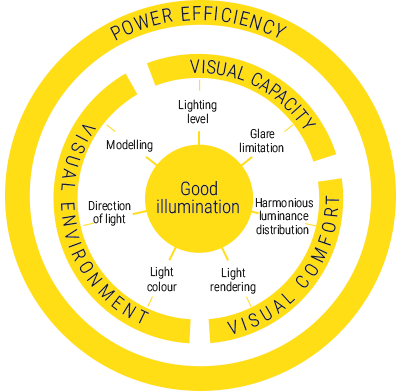
4.1 LIGHTING LEVEL
The lighting level is primarily defined by the level of illuminance. This in turn is dependent upon the visual task, and is oriented to the difficulty of recognising specific contrast and detail as well as the speed at which these must be perceived. The EN 12464 standard defines the required illuminance levels for various types of room and activity. Maintenance values specified for the illuminance levels are mean values for the workzones of the rooms in the specific working planes. Independent of the age and condition of the lighting system, the mean illuminance level must not fall below the specified value. For all lighting systems, illuminance levels decrease with increasing age of the lamps and because of the collection of dust. In addition, the reflecting peripheral surfaces of the room also usually darken with age or become dusty. The lighting system must therefore be planned according to a light loss factor that considers all influences and that was calculated for the intended lighting equipment, the spacial environment and the maintenance plan to be defined.
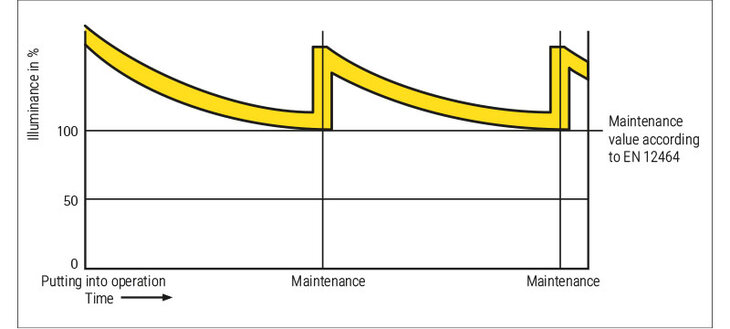
4.2 LUMINANCE DISTRIBUTION
The illuminance level in a room says little about a balanced and uniform distribution of the luminance on various surfaces. A homogeneous brightness distribution and the lighting level required for this are the prerequisites for well-being with people. Optimal viewing conditions are given when the luminance contrasts between the object viewed and the larger surfaces of its surroundings are kept within specified limits. The recommended luminance ratio between viewing task and the near or far surroundings should not exceed 3:1 and should not be less than 1:3. The luminance of peripheral room surfaces and the viewed object can be established by us with the aid of special programs.
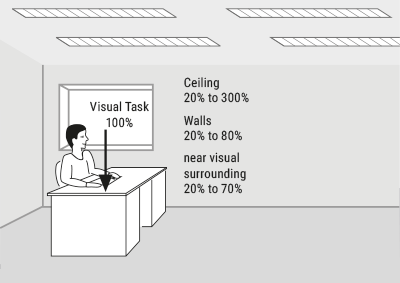
Recommended luminance ratio between visual task and the near or the distant surroundings.
4.3 GLARE LIMITATION
Direct glare is caused by excessive luminance in the field of view. It diminishes visual acuity (physiological glare) and may seriously lessen the sense of well-being (psychological glare). Methods of glare evaluation for indoor luminaires evaluate the limitation of luminance within the critical beam angle. As a standard evaluation system the UGR (Unified Glare Rating) method was introduced in Europe as the DIN EN 12464-1 standard. Details concerning the UGR method are described in the CIE 117 publication. The UGR value of a lighting installation, determined according to a table for the position of a standard viewer, is not permitted to exceed the value specified by the standard.
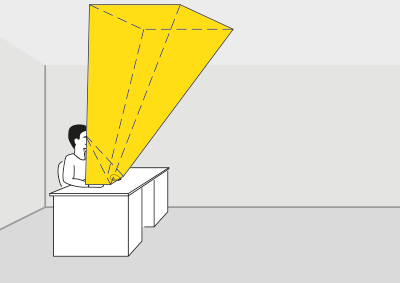
Reflected glare is caused by disturbing reflections on bright surfaces.
Reflected glare is caused by disturbing reflections upon blank surfaces.
As shown in the illustration, no light from the marked area should fall onto the working plane. According to the physical law ‚angle of incidence = angle of reflection‘, reflections occurring would lie precisely in the field of view of the person working there. Matt work surfaces help significantly in solving the problem of reflected glare. Reflected glare leads to similar disturbances as direct glare, and impairs mainly contrasts, which are required for disturbance-free seeing. The lighting of computer screen workspaces requires especially careful planning, because strong reflections on the screens often make work impossible.
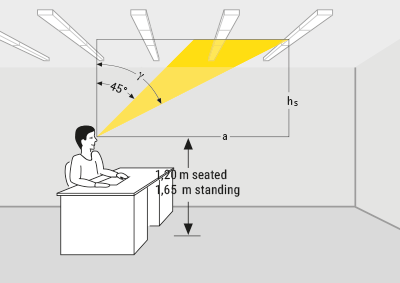
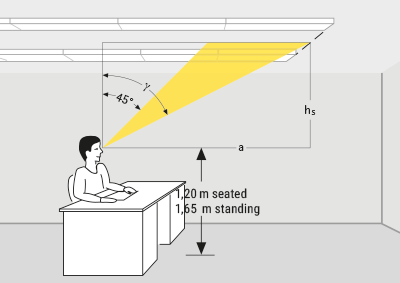
The reflective properties of the screen surfaces, the screen polarity and its curvature in combination with shining surfaces in the room are the decisive factors of influence for the assimilation of information via screens. Disturbing reflections can be lessened with anti-reflection measures for the screen surface. The suitability of luminaires is specified in DIN EN 12464-1. Depending on screen quality and screen polarity, the luminance values of luminaires and shiny surfaces reflected on the screens must not exceed the specified limitation values for mean luminance. Depending on these screen classes and the screen polarity, the luminance values of luminaires and shiny surfaces reflected on the screens must not exceed the specified limitation values for mean luminance. These limitation values are considered for luminaires above an emission angle of 65° all round.
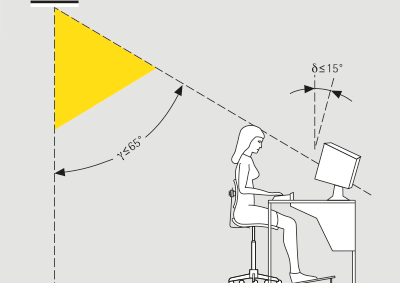
| "High state"-luminance of the screen | Screens with high luminance L ≥ 200 cd/m² |
Screens with mean luminance L ≤ 200 cd/m² |
| Case A Positive polarity and usual requirements with regard to colour and details of the presented information, e.g. as available in offices, classes, etc. |
≤ 3000 cd/m² |
≤ 1500 cd/m² |
| Case B Negative polarity and/or higher requirements with regard to colour and details of the presented information, e.g. as available in case of CAD, colour verification, etc. |
≤ 1500 cd/m² |
≤ 1000 cd/m² |
| Note: "High state"-luminance of the screen (see EN ISO 9241-302) describes the maximum luminance of the white area of the screen. Manufacturers of screens indicate that value. | ||
4.4 LIGHT DIRECTION AND SHADOWS
Light direction should fundamentally be oriented to the ingress of daylight. The correct arrangement of luminaires is an important prerequisite for the avoidance of direct glare. Angle-dependent reflected glare can be minimised through advantageous arrangements. (As the illustration shows, lateral light incidence prevents glare of shiny table surfaces. Lateral light with luminaire arrangements parallel to the direction of view is therefore the best solution).
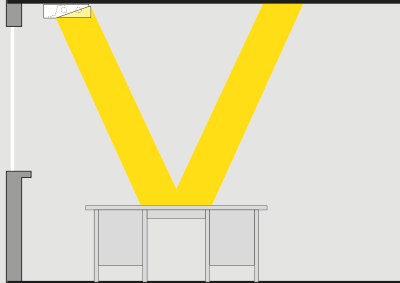
For good recognition of illuminated forms and surface structures, sufficient shadowing must be achieved with aid of the lighting. Strong shadowing in most cases is an advantage for emphasis of sales objects or for making danger spots visible. Balanced shadows with soft edges are desired though for the general lighting of indoor spaces. Directed light and strong shadowing. With general lighting, shadowing can be evaluated with the ratio of cylindrical illuminance EZ to horizontal illuminance E. Overshadowing is avoided when the ratio of E:EZh is not less than 0.3 at a height of 1.2 m above floor level. EZ is the mathematical mean value of the four vertical illuminance levels at the reference level of 1.2 m (see DIN 5031, Sector 3). The figures show shadowing with point-source lighting and with lighting arranged in continuous runs.
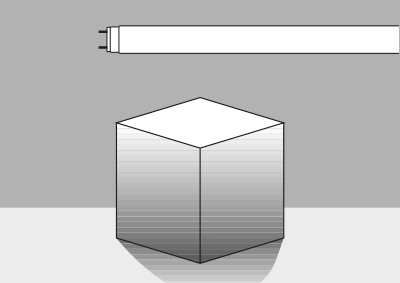
General lighting and balanced shadows.
4.5 LIGHT COLOUR AND COLOUR RENDITION
These factors contribute to visual perception and the recognition of our environment. Only with the right ‚colour climate‘ do people feel at ease. This factor is defined via the light source and its colour rendition properties as well as the colour design of the room. Light colour, colour rendition and the colour surroundings of a room must therefore be matched.
4.6 BIOLOGICALLY EFFECTIVE LIGHT
Light not only has a visual function but also a biologically effective component. If not enough daylight is available because people spend too much time in closed rooms, artificial light can assume specific functions of daylight and quasi delivers „the right light at the right time“. Based on the natural light, the artificial light is given a dynamic structure similar to the course of the day. Thereby, the changes in the level of illumination and in the light colour are of particular importance. This is achieved using luminaires with tunable white technology and a corresponding light control system. A lighting concept based on this goes beyond the standard quality features of a lighting system and focuses on human beings: Human Centric Lighting (HCL) is able to support the human circadian rhythm, stimulates the well-being and supports the stable health of persons.
4.7 ENERGY EFFICIENCY
As well as the above-mentioned classic quality attributes, the energy efficiency of a lighting system is becoming ever more important. With total costs of lighting over the complete utilisation period, costs for electricity amount to approximately 60%. 20% each are to be calculated for the factors of purchase and installation/maintenance. Energy-saving systems significantly minimise costs, relieve the environment and fulfill new legislative framework conditions (see 5.)